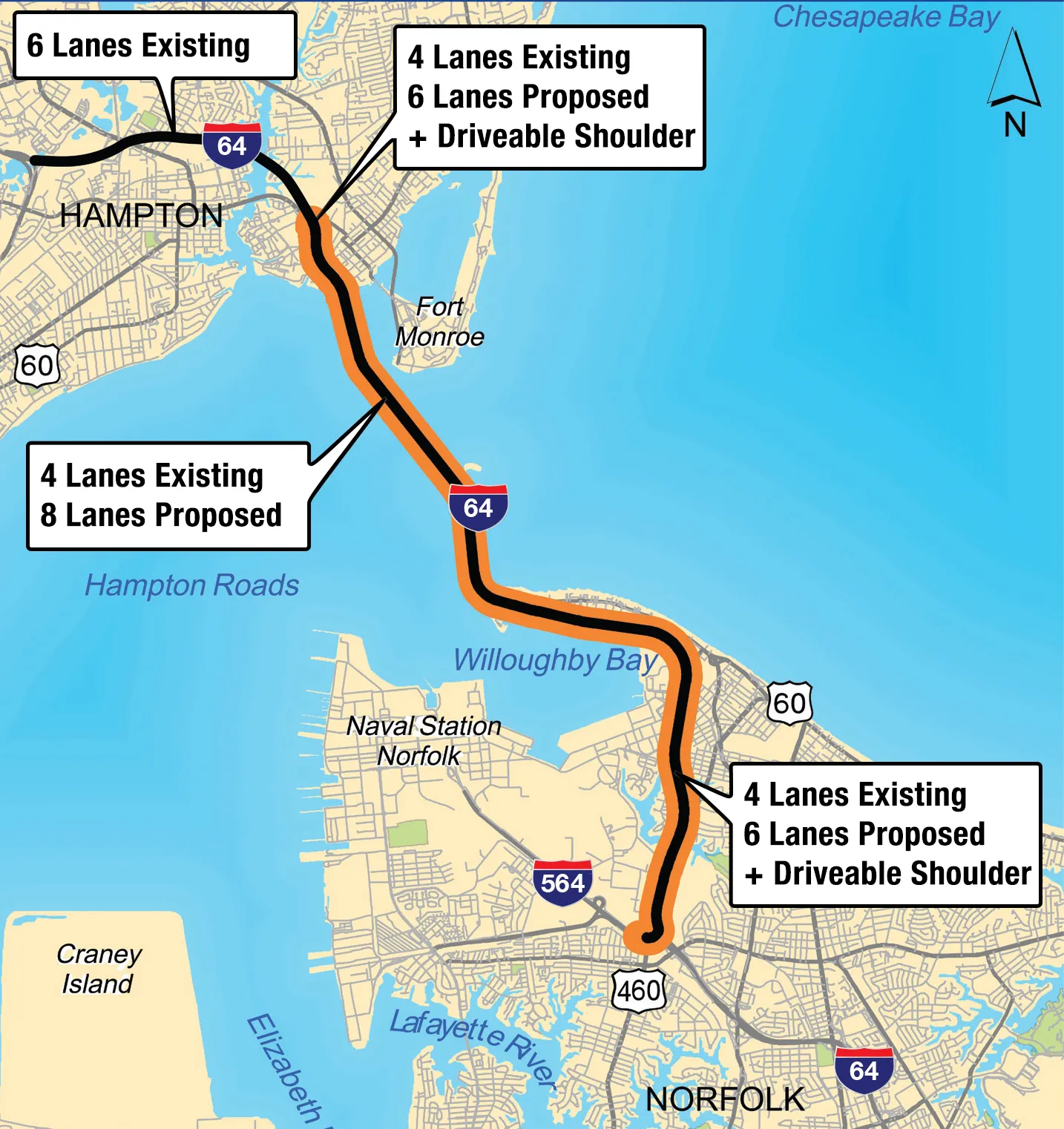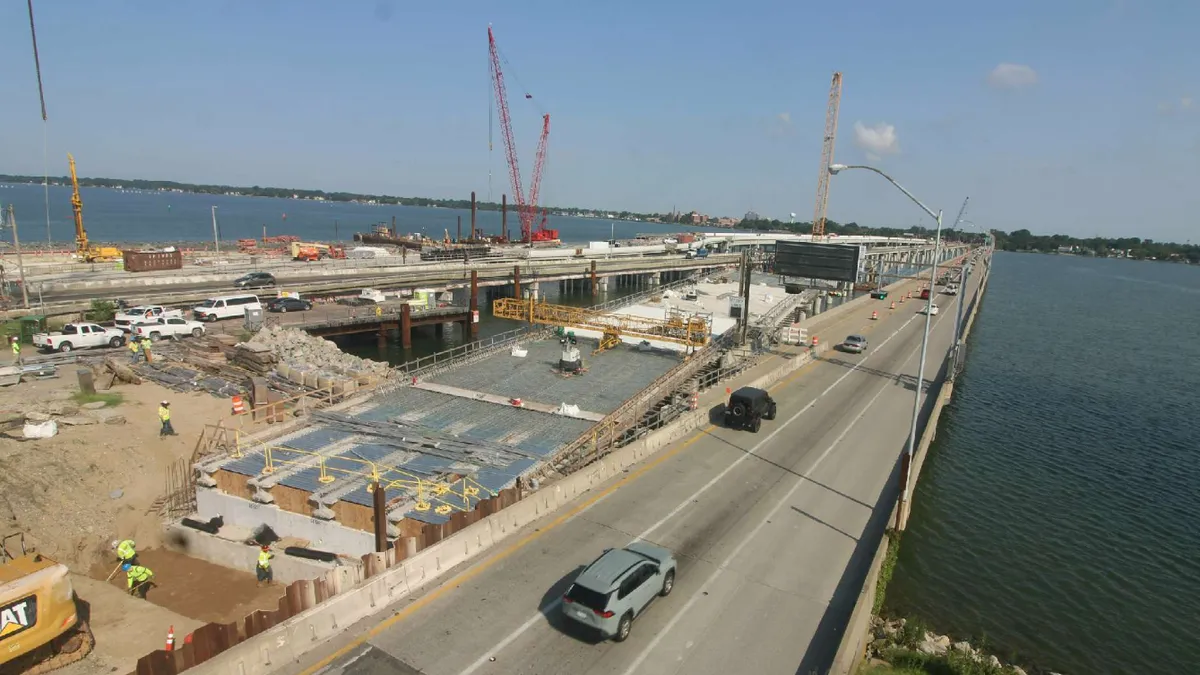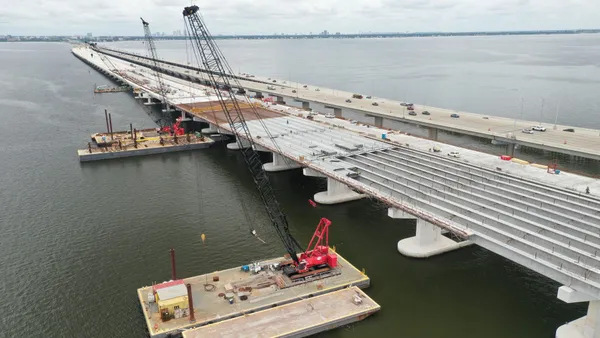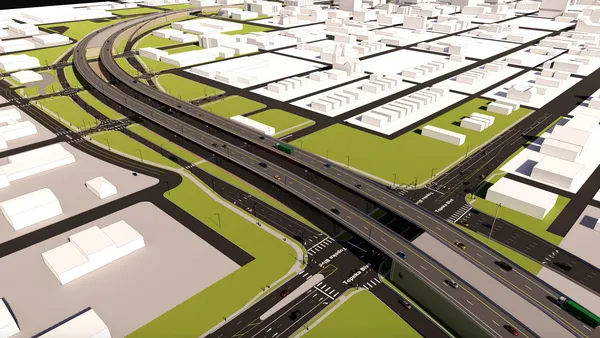Dive Brief:
- The $3.9 billion Hampton Roads Bridge-Tunnel, Virginia’s largest-ever transportation infrastructure project, is about half done but more than a year behind schedule, Virginia DOT spokesperson Brooke Grow told Construction Dive in an email. The 3.5-mile-long HRBT is made up of bridges, trestles, artificial islands and tunnels under the main shipping channels in Hampton Roads harbor.
- The complex expansion effort aims to address congestion and delays on the busy I-64 corridor. It entails building twin two-lane tunnels under the harbor — the fourth-ever bored tunnel for vehicular traffic in the U.S. — and widening 10 miles of I-64 from four to eight lanes between Hampton and Norfolk in southeast Virginia.
- The contractor, Hampton Roads Connector Partners, is a joint venture composed of Madrid-headquartered Dragados; Paris-area Vinci Construction; Broomfield, Colorado-based Flatiron Constructors and French engineering firm Dodin Campenon Bernard. Work started in 2020 and the contract completion date is November 2025, though it will likely be finished later.
Dive Insight:
The contractors will bore two new tunnels, both with two lanes, west of the existing eastbound tunnel. When finished, there will be four free general-purpose lanes and four high-occupancy toll lanes: two that are always available and two shoulder lanes for use during peak traffic times.

It is the first time that the state is using the bored-tunnel construction method, which Virginia DOT expects to be less disruptive to military and commercial maritime traffic in the busy channel. The magnitude and complexity of the effort have translated to delays, according to Grow.
“VDOT is navigating new, uncharted territory and adjusting course with the project team accordingly. We continue to monitor progress and address any challenges that may arise,” said Grow. “The department continues to work closely with the contractor to mitigate any production delays and to support HRCP as needed to ensure they achieve project milestones and deliver a top-quality product that our region’s travelers deserve.”
Tunnels affected by extreme weather
Intense storms associated with climate change are increasingly impacting infrastructure, and tunnels can be particularly vulnerable to flooding, according to the EPA. Examples of this have made headlines recently.
In July, at least 13 people died in a Korean traffic tunnel after a riverbank burst amid a severe rainstorm, rapidly flooding the structure and trapping cars. Closer to home, floodwater overwhelmed the Downtown Tunnel in Norfolk, Virginia, at the end of June after its pumping system failed. The tunnel only had to close for an hour and no one was harmed.
In July 2009, flooding shut down the HRBT for nearly seven hours after torrential rains from a thunderstorm caused a water main to burst and flow into the westbound tube, overwhelming pumps. A followup report found the structure saw fewer inspections and less maintenance than counterparts in other states, according to The Virginian-Pilot, and Virginia DOT adopted new detection equipment and procedures to prevent another such incident.
The original HRBT, first opened in 1957, was designed in consideration of its direct proximity to the bay as well as the potential ramifications of high-water events, and has numerous safety features, according to Grow. Virginia DOT also maintains standby emergency contracts to help it remove water from the open approach structures as well as the tunnels.
Currently, there are four tide gates that are tested at least twice a year to ensure they are functioning properly should they need to be closed in the event of an emergency. The HRBT is also equipped with several large capacity drain pumps in each tube that are designed to vacate water from the lower air ducts during extreme weather.
Project progress
Permitting is finished, design efforts are nearly finalized and work is ongoing in all areas along the project corridor, according to Grow. Mining operations began in late April and so far workers have dug more than 790 feet. HRCP crews have also installed 111 tunnel rings.
HRCP crews are now working on three marine trestles that connect Norfolk and Hampton to the two artificial islands, Grow said. Work is continuing on widening I-64, east and westbound, along the corridor and on nearly 25 other bridge structures.
The Hampton Roads Transportation Fund is paying for 95% of the project with regional gas and sales taxes, and Virginia’s Smart Scale program adds another $200 million. Virginia DOT is also spending $108 million to replace trestle bridges on the Norfolk side of the project.
You can watch live video feeds of the project here.















